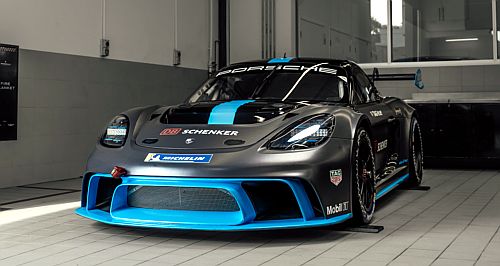Make / Model Search
News - Porsche - Race carsPorsche racing to an all-electric futureCharging challenges and realistic power outputs are just some of the considerations14 Mar 2024 RACING an electric car is just like driving a road-ready EV, or any other combustion model, for that matter – if you go too hard, too soon, you will not last long before something goes wrong.
As such, Porsche’s GT4 e-Performance electric racing prototype sports car has a ‘modest’ 1088 horsepower, or 800kW, and the project manager for that car, Björn Förster, said that it would be too easy to uprate the power output, but there’d be too much compromise in doing so.
“We could do it, but it doesn’t make sense,” said Mr Förster.
“We run it at more than 1000 horsepower, and we can run it at a top speed now of 285km/h. That’s the maximum speed of a Cup Car.”
Mr Förster said that upping the power output would simply degrade the battery faster, and suggested that in future, he’d love to see an electric racer based on the ‘983’ new-generation 718 Boxster and Cayman models going toe-to-toe with 911 Cup racers.
“I would love to have those racing parallel, in the same race - that would be great fun. Even when the lap times are on the same level, the style of driving will be completely different,” he said.
“You have to keep in mind that you have to handle the energy management, because this car is a bit heavier than the Cup Car so you have to accommodate that, and you also have to adapt your driving style.
“So out of corners you really have to push it hard, then go into lift and coast very early. Then early soft braking, late hard braking. That’s the way you can drive it the most efficiently, and also fast.
“If you run this car for the same lap time but with the driving style of a combustion engine car, you will end up with 20 mins run time, not 25 to 30 minutes. So even if you run the same lap times, it’s a big influence based on the driving style.”
Mr Förster also pointed out that, around the world, race tracks are more likely to build EV charging stations in the car park, not the pit lane, of the circuit, and that has led to obstructions for showcasing the prototype model’s ability at different locations around the world, joking that there’s just one location in Japan that has got it right so far.
However, he concedes that, with current battery technology, there are limitations to how long a car will be able to race - maybe it’s a happy synergy in the attention-lapse society we live in, but as Mr Förster states, the prototype model is only really capable of about 30 minutes of full-speed racing.
That’s despite the fact that, while both motors combine for an output 800kW of power, they can also recuperate 800kW of power under regenerative braking.
Mr Förster pointed out EV race cars will be easier for less experienced drivers to get to grips with, with the removal of a transmission and gear shifts, not to mention throttle and brake management to coincide with that, making for a easier to master.
“You’re talking to a motorsports guy,” he prefaced the following comments with. “It doesn’t make you faster, but… imagine a 983 GT4 - therefore, it’s an emotional car, so this could be an option where, maybe, this car comes out, and it’s just mandatory for sporty electric cars to have a shifting simulator.”
“Not because of getting the car faster,” he asserted.
“No record on any racetrack will be done with manual shifting. It even shows you the revs, which are fake. But if I’m working in motorsport, I would avoid that.”
The simpler nature of an electric powertrain also means that, according to Porsche’s calculations, EV racing car owners are set to benefit.
“I would say the regular combustion engine race car with about 75 hours of racing costs about 70,000 to 100,000 euros to rebuild,” said Mr Förster, who explained the durability of the battery system and electric motors employed in the GT4e-Performance is significantly more sound than a combustion engine model, in theory at least.
“So, as long as you can keep it at 45 degrees, there won’t be any damage,” he said of the battery system, which is cooled by a Mobil 1 oil-cycling system.
He indicated that technology may not be found in electric production cars, but there could be a possibility in hardcore EV racers of the future to have something similar.
Porsche is set to introduce its new electric sports car models – the 718 Boxster convertible and the 718 Cayman coupe – in the coming years.
Production versions are expected to borrow some learnings, and some technology, from the racing prototype, but Mr Förster confirmed that the brand will offer the ‘standard’ or ‘street’ versions of the 983-generation models well before any racing model is offered to public customers.
The GT4 e-Performance model takes an existing version of the 718 Cayman and frankensteins a Porsche Taycan sedan’s battery bank across three positions in the body – under the bonnet, in the passenger foot well, and behind the seats, where the production EV sports car pairing will likely have a specific platform with the battery mainly housed behind the seats for better weight distribution.
 Read more |
Click to sharePorsche articlesResearch Porsche Motor industry news |












Facebook Twitter Instagram